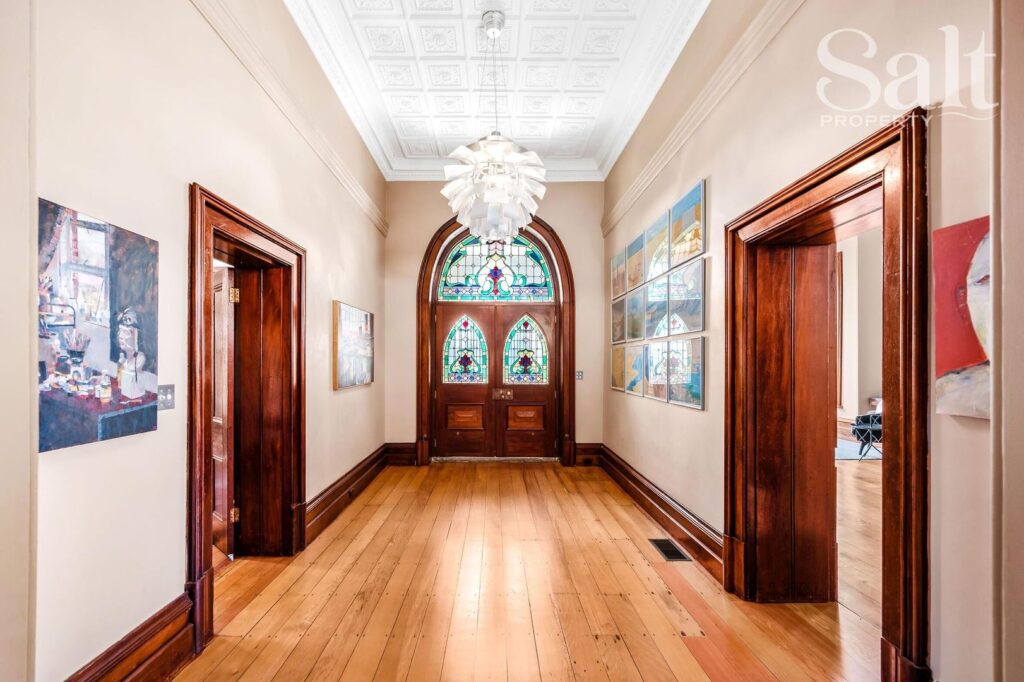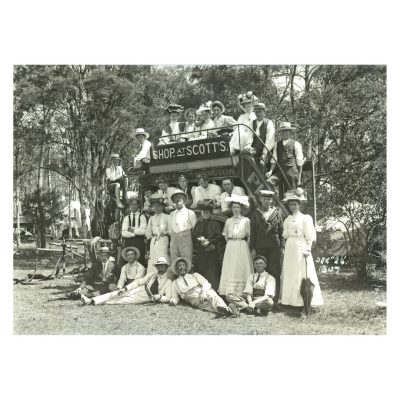
Built in 1861 by Edward Christopher Merewether 1820-1893, The Ridge has enjoyed several generations of families living in it, several more as a maternity hospital, and survived threatened demolition in the 1980s.
Fortunately, a permanent conservation order was applied in 1984 before state heritage listing in 1999.
IAN HEALY’S Suburbia, This Week Humanity And The Unmarried Mother [1951]
Early in the 1920’s, a stately old home in the Merewether hills passed into the hands of the Salvation Army. It became one of the Army’s small, nation, wide chain of buildings (two to a State) in which trained women officers slapped, not tambourines, but the backsides of newly-born babies.
Christened “Hillcrest,” the old home opened as a private maternity hospital on American Independence Day, 1925. In the 26 years since, its staff and visiting doctors have assisted into the world more than 8100 babies, an average of almost one a day. Like its kin hospitals, public and private, it has seen the birthrate decline through depression’ years and rise to the postwar peak that sent authority running for extra beds and taking tentative bookings eight months in advance. Wealthy, middle-class and poor have gone into the 20 beds of its two private and three intermediate wards. To the city at large, there is probably no difference between “Hillcrest” and any other hospital of its kind; but here, as at all links in the chain, is fulfilled, in a separate, much more private part of the establishment, a little-known branch of the Army’s humanitarian work. It is the care of the unmarried mother.
THE WORK had its beginning in London in 1886 when Mrs. Josephine Butler, a Salvationist of humble birth, and Mrs. Bramwell Booth, wife of the second General Booth, grew alarmed at the city’s large number of young, unmarried mothers and at the attitude of officialdom and public towards them and their children. Deciding to offer a helping hand, the two women renamed Mrs. Butler’s modest house “The Refuge” and turned it into a 19th century midwifery centre, cum welfare bureau. Whenever they found a lonely girl in trouble, they took her to “The Refuge” and tended her from confinement through to the stage where they could find her employment or set her on a happier way of life. Not all their “refugees” came from prisons and the back-street slums. Some were the errant, disowned daughters of well-to-do families. Mrs. Booth and Mrs. Butler found (as the Salvation Army finds to-day) that their chosen charges had no more than the crudest knowledge of sex and that most of the so-called “bad” girls were good at heart.
“The Refuge” thus became the Army’s first maternity hospital and marked the start of its vastly-extended social services. “Hillcrest” is the only hospital in Nevwcastle doing this work. Some of the unmarried mothers it assists are as young as 14. The Matron (Major F. Nixon), who was stationed in Queensland during the war andt aided at the birth of dozens of demi-orphan, American-fathered children, said: “Someone must help them. It is one of the most important branches of Salvation Army work.”
Unmarried mothers shy away from the big public hospitals where there is little privacy and they may happen to be seen by people who know them or who might deepen their humiliation. Few enter even the private hospitals in their own cities for the same reasons. To “Hillcrest” come or are sent girls from other cities and States,. from country towns where they or their sad, quiet parents may have sought the advice of Army officers, or where officers have found them, as desperately alone as the girls of “The Refuge” days.
They enter “Hillcrest” as early as they please before confinement. When their babies are born, the Army finds the mothers employment or, when the environment is satisfactory, sends them home. Many have no desire to part with their children, but when the wish is expressed to have them adopted -and only when the wish is expressed-this is arranged through the Child Welfare Department.
Though their section of the hospital is kept remote, even, as far as possible, to the extent of a separate operating theatre, the unmarried mothers receive the same treatment, food and medical care as the patients in the married women’s wards. The married women’s wards occupy the best part of one floor in the two-storied building. Adapted from the best rooms in the house, they offer wide window panoramas that fan out across the suburbs to the western hills, the harbour, the coastline and the sea.
WOMEN in window beds can watch the colliers breezing up and down the coast and, gazing out on the peaceful-looking city, may say, as one in a private ward declared this week: “This is absolutely perfect.” Perfection may have waned a while in the war years, when black out shutters hid the starlight view, and a nurse, who forgot the shutters one night, received a call from ai different Army telling her that the emergency light she carried could “be seen for miles.”
When the war seemed at its worst, preparations were made to evacuate the hospital, but the only invasion that came its way was by invitation, when the staff. one Christmas Day, asked the soldiers down from their guns in the hills to tea. All but one of the wards, a private balcony room, are known by their colour schemes. There are the blue ward, the pink, the cream, and the little pink. In them, the wallpaper, fruit howls, bedtable and locker covers match. High-ceilinged and cool in summer’s heat, the wards were bedrooms when the house was the residence of the Merewether family from whom the suburb took its name.
Originally, a large portion of Merewether, known then as the Burwood Estate, was owned by Dr. James Mitchell. a Scot who in 1820 was appointed assistant surgeon of the 48th Regiment, New South Wales. He bought the estate in 1836, and gradually added to it. His eldest daughter married Mr. Edward Christopher Merewether, who arrived in Australia to be aidede-camp and private secretary to a succession of State Governors and who, in 1860, was appointed General Superintendent of the AustraItan Agricultural Company, a firm with extensive holdings in the Newcastle district.
Mrs. G. S. F. Merewether, who lives not far away, said the home was built by Mr. E. C. Merewether (her father-in-law) about 90 years ago. It was given the name “The Ridge” and for years, Mitchellstreet was its private driveway. The drive was barred by a gate that stretched across near the present junction of Mitchell and Patrick Streets. Later, as the area was subdivided, the gate was moved back towards the hills, to the junction of Patrick and Ridge Streets, and the words “Ridge Gate” were erected on a nearby house. The gate, moved once again, still farther back to Curry-street, no longer exists and the driveway to “Hillcrest” has grown infinitely shorter.
As the area’s meadows, scrublands and sand patches gave way to houses, so the coalmine that began near Caldwell-street and burrowed into the hills has gone, and wvith it the smelting works over the ridge near Smelter’s Beach, the coke ovens near the Merewether Beach reserve, and the dam in the gully to the west of “Hillcrest,” where children went rowing and wild lilies grew.
TODAY, there are sewage disposal works at Smelter’s Beach, a few hundred yards from the coke ovens site is the city’s only night club, and the dam in the gully is no more than a trickling thin creek where youngsters go gathering tadpoles and hunting frogs. On the once thickly-wooded slopes of the ridge, horses graze. A new road rises to the heights; and up there, where a bagpipes player once went to practice in seclusion, houses with unrivalled views are being built.
As its surroundings have changed so, too, has “Hillcrest.” From the stables (now a laundry and storeroom) to the back room that became an operating theatre, the home has been so altered that probably only one room -the reception room-still serves its original purpose.
Improvements are constantly being made to its facilities. In October, the nursery doors were glass-panelled so that fathers could look in and see their offspring at what is called “baby show” time. This week, more than £1000 worth of new sterilising equipment arrived for installation. The sterilisers, like most other equipment, are electric. They are susceptible to the power restrictions that affect the suburb, but the hospital-in the words of the Deputy Matron (Major J. L. Biggs) has “always found the Electric Supply Department most cooperative.”
“If ever we have an emergency during a blackout, we have only to phone the department and it will switch on the power again in a matter of seconds,” she said.
Mrs. Merewether, who lived in the old home, can see it from the front windows of her newer residence (also called “The Ridge”). She has staunch admiration for the Army work at “Hillcrest.” “Four generations of the family have been born there,”she said. “My husband, my children, grandchildren and great-grandchildren.”
“Mrs. Merewether never forgets us,” Major Biggs said. “Every year, she sends a donation for Christmas cheer.” The donation buys gifts for the married and unmarried mothers and their babies. Patients, too, remember the hospital with grateful gestures.
Many go back to show the staff (all, but one, trained Salvation Army officers) how their children are progressing. A stainless steel baby bath which the hospital hopes to acquire soon will be bought with their donations. Later in the year, Major Nixon hopes to hold an afternoon, at which “Hillcrest’s” past patients and staff may meet again.
Newcastle Morning Herald and Miners’ Advocate (NSW : 1876 – 1954), Saturday 7 April 1951, page 5
There were also many celebrations at Hillcrest with a ‘Back To Hillcrest Day’ held for mothers and babies for many years. The first Back to Hillcrest Day was held on 3 November 1951 and was such a success that more than 300 people attended the second event in 1952.
“Back To Hillcrest” HILLCREST Maternity Hospital, Merewether, will hold a “Back to Hillcrest” day on November 3 for mothers who have been patients at the hospital in the past 26 years. The mothers will be asked to bring children born at the hospital. SThe Matron (Major Freda Nixon) said yesterday that she expected some 20-year-old “babies” to attend. The idea was to get former patients and their children together in a type of reunion. Commissioner J. James, of Sydney, will preside. The Lord Mayor of Newcastle (Aid. Purdue) will be among official guests. A musical programme will be given by Newcastle Salvation Army Citadel Band. Devonshire afternoon tea will be served, and there will be stalls.
Newcastle Morning Herald and Miners Advocate – 18 October 1951


The Ridge in 2023
Feeling a bit nostalgic or looking for your dream home? The Ridge is for sale in 2023 for somewhere around $10 million …




Share your stories of Hillcrest Hospital and The Ridge residence!








0 Comments